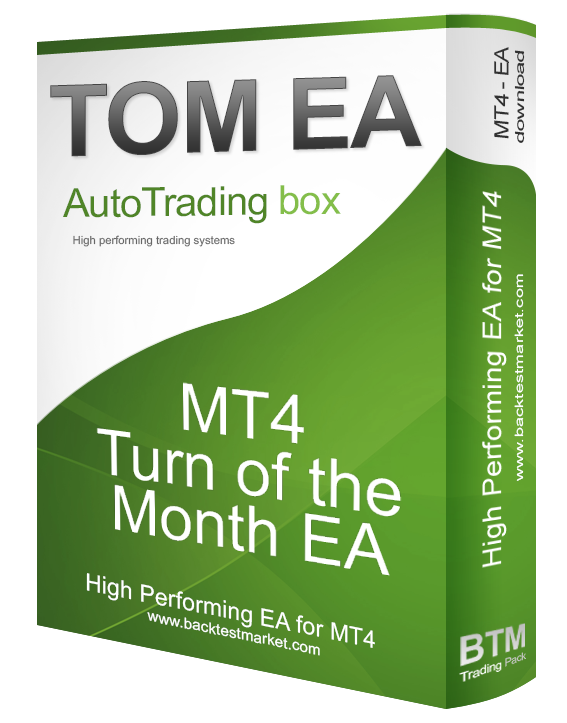Turn Of the Month effect (TOM)
Turn Of the Month effect manifests itself in some Tickers that have anomalous returns around the end of one month, and the beginning of the next.
To spot a TOM anomaly in markets there are these 3 strategies.
All ones close the position at the closing price of the 3rd trading day of the new month, while the entry day differs.
The 3 strategies are:
- TOM FNM
it opens the position at the opening price of the 1st trading day of the new month; - TOM LPM
it opens the position at the opening price of the last trading day of the ending month; - TOM L4PM
it opens the position at the opening price of the fourth to last trading day of the ending month.
Literature review
First Research
Lakonishok and Smidt in 1987:
- started from Ariel’s work, in which he showed that Dow Jones returns in the 1st part of the month were significantly higher than the ones of the 2nd part
- noted that the performance in the 4 days around the end of the month was 0.473%, while the average of returns over a period of 4 days was 0.0612%. It means a 7 times greater return.
- Results were subsequently filtered to investigate for the “Turn of the Quarter” (or “End of the Quarter”) effect. The "end of quarter effect" refers to the end of each quarter: in March, June, September, and December.
Although the turn of the month is a simple anomaly, it was, and currently is, a big challenge for the academic world to explain the potential reasons. The paper has demonstrated that higher risk does not explain the turn-of-the-month effect: using the standard deviation of returns as as a measure of risk it was found that risk is not higher during the four turn-of-the-month days than over the other 16 trading days of the month.
Interestingly, they saw also that Turn-Of-the-Month effect occurs in 30 different markets, so the effect is not due to a factor unique to the U.S. market structure.
Second Research
Ogden (1990):
- puts forward the hypothesis that the Turn-Of-the-Month effect is due to a “regularity in payment” dates, at least in the U.S., since investors receive a preponderance of compensation from employment, dividends, and interest at month-ends. Consequently, as investors seek to invest these funds in these days, and equity prices are pushed up.
- But then the paper provided tests that reject this hypothesis.
Third Research
McConnell and Xu in their paper “Equity Returns at the Turn of the Month“ found difficulties to explain the reasons of the anomaly. They affirm that:
“This persistent peculiarity in returns remains a puzzle in search of an answer.”
Other Research
The majority of the research ascribe the Turn-Of-the-Month effect to:
- the timing of monthly cash flows received by pension funds, which are reinvested in the stock market.
- the rebalancing of portfolio and trading models, both for retail and professional investors, since the end of the month is a natural point to do that.
Another reason linked to the second above, is that TOM is made up by 4 Turns-of-the-Quarter each year. And "end of quarter" periods are considered very important for investors because different data are published regarding various market indicators, so investment funds and financial managers tend to:
- review the composition of their portfolio to change the strategy or to set new goals to adapt their portfolio to the events of the quarter, or to try to get better performance;
- do a traditional rebalancing that consists into selling assets that have given good returns during the quarter and buy assets with low performance (losers), so taking profits on the winning positions and allocating part of these to the loosing stocks, with the hope (supported by mean-reversion studies) that they can turn bullish.
The authors recommend taking caution to implements this strategy in a portfolio, since in general calendar effects tend to vanish or rotate to different days in a month. However this effect has been continuing unchanged for over 70 years
TOM strategy applied on S&P 500
Following, the average return of TOM LPM strategy on S&P 500. The strategy:
- buys at the opening price of the last trading day of the ending month, and
- sell at the closing price of the third trading day of the new month;
- keeps the position open 4 trading days each month.

It can be noticed that the average gross return of the strategy in the entire period from 1928 to 2021 (0.48%), has been 4.36 times greater than the average return of S&P 500 in 4 trading days (0.11%).

Turn of the month effect - MT4 Expert Advisor
Starting from 1987 Ariel’s work, in which he showed that Dow Jones returns in the 1st part of the month are significantly higher than the ones of the 2nd part of the month, Lakonishok and Smidt (1987) noted that the performance in the 4 days around the end of the month was 0.473%, while the average of returns over a period of 4 days was 0.0612%
To trade automatically this anomaly, you can purchase the "TOM Expert Advisor". The Expert Advisor needs the "Main EA and libraries" to work. If you have an active ForecastCycles membership, contact us to get 20% discount.




